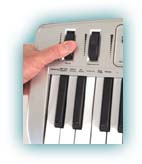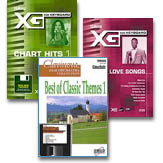|
Those of us
musicians who've been around for a while
remember our first keyboard. They had just a few
voices to choose from and maybe a few accompaniment
styles, and that was it! Today's portable keyboards have tons of
new features. We can't possibly address them all, but there
are a few more easy-to-operate features worth considering for
your purchase.
Controllers
 Foot
Pedal --
Most keyboards have one or more foot pedal jacks so you can
plug in a foot pedal to control sustain and possibly other
functions. Like the sustain pedal on an acoustic piano, sustain
holds or prolongs a note after you lift your fingers from the
keys. A beginner piano student does not need sustain. Soon
into your lessons, however, you'll likely be playing songs which
require sustain. On most portable keyboards, the foot pedal is
sold separately. Foot
Pedal --
Most keyboards have one or more foot pedal jacks so you can
plug in a foot pedal to control sustain and possibly other
functions. Like the sustain pedal on an acoustic piano, sustain
holds or prolongs a note after you lift your fingers from the
keys. A beginner piano student does not need sustain. Soon
into your lessons, however, you'll likely be playing songs which
require sustain. On most portable keyboards, the foot pedal is
sold separately. Pitchbend wheel
--
Some keyboards have a pitchbend wheel.
Depending on the direction in which the wheel is turned, you can
"bend" the pitch of the note being played either up or
down. It's the same effect as a guitar player bending a guitar
string to slightly raise or lower the pitch. Consider a
keyboard with a pitchbend wheel if you want to emulate
more realistic
electric guitar playing, achieve a trombone slide, or
mimic a saxophone and harmonica player when they bend
notes. D-beam controller --
You'll only fine the D-beam controller on some of Roland's "Arranger" keyboards, but it's such a
blast to use that we just had to tell you about it. You simply select one
of the preset D-Beam templates and start waving your
hand through the D-Beam's infrared beam of light. You
can increase or decrease tempo, mute parts, stop the
accompaniment, trigger sounds like explosion and
gunshot, trigger a fill-in, and the list goes on and on.
Great fun. Registration Memory
 So,
you've concocted the perfect settings for your favorite
song, including the style, voices, tempo, volume,
effects and a few other panel settings. Imagine your
frustration if each time you wanted to play the song,
you first had to remember all the changes you made the
last time you played it. On many portable keyboards, you
can store your settings in a registration memory. The keyboard can
instantly recall a particular song's setup with the
press of a button. This feature is a must if you're
planning on performing live, because you can store your
settings for each song prior to going on stage. So,
you've concocted the perfect settings for your favorite
song, including the style, voices, tempo, volume,
effects and a few other panel settings. Imagine your
frustration if each time you wanted to play the song,
you first had to remember all the changes you made the
last time you played it. On many portable keyboards, you
can store your settings in a registration memory. The keyboard can
instantly recall a particular song's setup with the
press of a button. This feature is a must if you're
planning on performing live, because you can store your
settings for each song prior to going on stage.
Floppy Disk Drive
There's a limit to the amount of
music data you can keep inside the portable keyboard's
internal "flash" memory, just
like with a computer. You might want to save more
creations than your keyboard has space for. You might also
want to get data into you keyboard. Most keyboards save
and load data using a built-in floppy disk drive.
It's available on some low-end keyboards and on all mid-
and high-end keyboards.
 What kind of "data" can you save and
load using a floppy disk drive? You can: What kind of "data" can you save and
load using a floppy disk drive? You can:
- save your recorded songs onto a floppy disk --
this gives you unlimited storage for your original
compositions. Share your disks with the members of
your band!
- buy floppy disks of pre-recorded performances by your favorite
artists -- there are hundreds available from The Beatles to Orchestral Jazz to
Assaff Weisman Plays Schubert! Simply load a disk
into your keyboard's floppy disk drive, then listen or
play along.
- load additional accompaniment styles from a huge variety of style disks
 previous
previous
|
